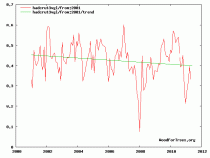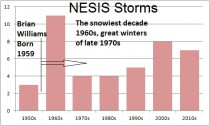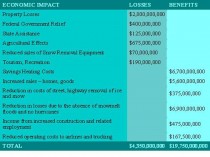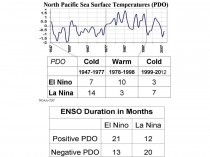By Joseph D’Aleo, CCM, Weatherbell Analytics
The media and warmists in the enviro and academic community have been troubled by the lack of warming the last decade. And Dr. Spencer shows it is in free fall again in October and early November.
The winters have been especially concerning (PDF) with US winters cooling 4.13F the last decade with cooling in every climate region.
They have latched onto extreme events as proof their climate change thesis. Again these journalists (the term is a stretch nowadays) and global warming scientists have no sense of history.
NBC’s Brian Williams in a special report after the Snowtober storm in the northeast said he did not remember weather like this when he grew up. Brian Williams grew up in Elmira, NY, born in 1959 so was a child during the snowy 1960s. He missed the hurricanes of the 1950s although his family lived in New Jersey then. He was a child when the tornado outbreaks of the 1960s and 1970s occurred and was likely in college (where his 18 college credits from Catholic University in DC likely did not include science) while he interned for Jimmy Carter’s administration when the great winters from 1976-1979 occurred.
NOAA has compiled a list of the most impactful eastern snowstorms since 1956 (NESIS). The 1960s is still the most prolific decade even after the flurry of major snows in recent years (something the IPCC, the Union of Concerned Scientists and other advocacy groups said would be become rare not increase)
His $10 million a year salary doesn’t help his memory much I guess or he is one of many people just oblivious to weather.
The 1930s had the greatest most widespread heat and drought, the 1930s to 1950s the most hurricanes, the 1950s to 1970s the most significant tornado outbreaks. There have always been floods and droughts - no trend has been found in either. A new study conducted by federal scientists found no evidence that climate change has caused more severe flooding in the United States during the last century. The U.S. Geological Survey (USGS) study - titled “Has the magnitude of floods across the USA changed with global CO2 levels” - found no clear relationship between the increase in greenhouse gas emissions blamed for climate change and the severity of flooding in three of four regions of the United States.
A draft UN report three years in the making concludes that man-made climate change has boosted the frequency or intensity of heat waves, wildfires, floods and cyclones and that such disasters are likely to increase in the future.
Never mind that all the previous model based forecasts are failing. Temperatures instead of accelerating have flatlined, sea level is falling not rising, snow is increasing not diminishing, the winters are becoming colder not warmer, the global hurricane ACE index is near a 30 year low and on and on.
But lets come back to what we expect to happen. We believe the earth’s climate though locally influenced by man is controlled on the larger scale by changes in solar activity, by decadal oscillations in the oceans and volcanism (even moderate high latirtude ones).
Now in their effort to explain away why warming and sea level rises stopped even as CO2 continued to rise, they are discovering cycles.
“What’s really been exciting to me about this last 10-year period is that it has made people think about decadal variability much more carefully than they probably have before,” said Susan Solomon, an atmospheric chemist and former lead author of the United Nations’ climate change report, during a recent visit to MIT. Though they use these cycles to explain the lack of warming or the cooling the last decade, don’t expect them to to give any credit to them for the warming from 1977 to 1998.
What is ahead...well more extremes but not because of CO2 but because extremes occur when the Pacific is cold and Atlantic warm and when the sun is less active, all currently in progress.
Let me reprise what I wrote in early June about the La Nina relationship to extreme weather.
Would You Believe La Ninas Often Hurt the Economy More Than El Ninos?
There have been great extremes of weather in the last few years. Although many environmentalists and their supporting cast in the media want to blame green house gas related climate change, they are only partially right. Climate is changing…always has and always will. The only constant in nature is change.
The kind of extremes we have experienced are related to a climate change to a cooling planet after a warming period, both associated with 60 year cycles in weather related to multidecadal cycles on the sun and in the oceans.
The last time we underwent such a cooling from the 1950s to 1970s, we had a similar combination barrage of extreme weather with drought, snowstorms, bitter winters, spring tornadoes and floods and hurricanes.
Some of you may remember, in the 1980s and 1990s, before the media’s favorite weather topic was climate change or global warming, it was all El Nino. It was blamed for virtually any weather event that occurred in El Nino years. It is true that El Ninos when strong are capable of producing losses that can total in the billions of dollars. El Ninos are feared in places like Indonesia, Australia, India, Brazil, Mexico, and parts of Africa where devastating droughts are possible. In the United States, southern states from California to Florida are vulnerable to damage from a barrage of strong winter storms.
Here in the United States, the El Nino of 1997/98 played a role in 18 President declared disasters with a total damage exceeding $4 billion.
However, the patterns of weather associated with strong El Nino events also produce many very positive effects and benefits.
For example, the milder temperatures of most strong El Nino winters in the interior northern United States reduce heating costs for both homes and industry and the operating costs for transportation both by air and on land. Less snowfall in the north lowers the costs of snow removal for government and industry, and enables the construction industry to work more during the winter months. Shoppers are able to get to and from stores more easily and often and retail sales benefit. El Nino also typically results in less flooding during the spring and fewer hurricanes in the summer.
Stan Changnon, former head of the Illinois State Water Survey in the Bulletin of the American Meteorological Society in September, 1999 estimated the economic gains and losses during the great El Nino of 1997/98. He showed that the benefits were much greater than the losses.
LA NINAS ON THE OTHER HAND…
In La Nina, the picture is very different from that of El Nino. When periodic outbreaks of extreme cold weather and snow occur across the northern states, the costs of heating, snow removal, fuel for airline and trucking industries can become at least regionally significant. As snowstorms hit northern areas and snow and ice storms occur across the south or east, business may be shut down for days with major effects on commerce. Retail sales may be down due to travel difficulties. Construction work will be hampered with delays and loss of employment.
Also in La Ninas, losses from springtime flooding and from droughts and hurricanes typically are much greater than normal. Flooding in La Nina years averages nearly $4.5 billion compared to an average of $2.4 billion. We have already seen examples of that in 2008 and 2009 in Missouri and Arkansas and this year in the Ohio, Mississippi (worst since 1927), Champlain and now Missouri River Valleys.
Major tornado outbreaks occurred in January 1999 in Arkansas and Tennessee and in May in Oklahoma and Kansas with $2.3 billion in damages. And of course the super tornado outbreak of April 1974 with its 148 tornadoes that left 315 dead and 500 injured occurred during a very strong La Nina. And in the la nina year of 1967, there was the Palm Sunday outbreak. In 2008, we set a record for tornadoes in May, this year in April. The outbreaks this year focused more on the major urban centers with greater resulting damage and death toll.
A major heat wave and drought in the strong La Nina of 1988 caused an estimated $40 billion in damage or losses (mostly agricultural) in the central and eastern United States. 2010’s summer La Nina brought record heat like 1988 but not the drought because the winter had been so snowy and wet and the soils saturated. This winter and spring drought in the southern plains is very costly. In Texas it was the third worst May drought behind only 1918 and 1956.
Hurricane related losses in La Nina years, averages $5.9 billion compared to an all year average of $3 billion. In fact, most all the major east coast hurricanes have been in La Nina years especially those with a warm Atlantic as we have currently.
SOME BENEFITS TOO
On the other hand, the winter sports industry may benefit in the west and north from increased snowfall. The last three La Nina years have been boon years Though the northern tier pays more for energy costs with cold winters and the occasional hot summer, many others save on their energy bills. This past winter was unusually cold in Florida in December into January but spring warmth followed early.
Warmer than normal temperatures in the big cities of the east and south in most La Ninas may save consumers there billions through reduced heating costs. Tourism in ‘escape’ destinations like Florida and California is usually up. Sales of snow removal equipment and winter clothing are also higher in the north and west.
But unlike El Ninos, the benefits are often dwarfed by the losses.
TIES TO THE PACIFIC DECADAL OSCILLATION
The frequency of both El Ninos and La Ninas is tied to the PDO. When the PDO is warm (positive) more El Ninos are favored and when negative La Ninas. The PDO phases average about 25-30 years in length. Though the PDO is a measure of conditions from 20N to the North Pacific, it turns out that warm water is favored in the tropics during the warm phase and cool water in the cool phase. This is what predisposes the Pacific towards an El Nino or La Nina state.
It appears the PDO which flirted with a change to negative in the late 1990s has returned solidly to a negative cold regime state. This is consistent with the 25-30 year phase length as the last shift called the Great Pacific Climate Shift occurred around 1977. If indeed it stays there this time, we can expect more La Ninas like this one in the years ahead just as we found in the last cold phase from 1947 to 1977. If that is the case and we see more La Ninas like this year, look for
(1) With more La Ninas than El Ninos, declining global temperatures especially as the Atlantic cools and during quiet solar periods or when volcanism increases
(2) More cold and snow across the northern tier from the Pacific Northwest and Northern plains to the Great Lakes and New York and New England. Ice storms are also more frequent on the southern end of the snow bands. they can be just as devastating as the early heavy snowstorm before the deciduous trees shed their leaves the last week. Recall 1973, 1974, 1997, 2008 for some recent examples in the northeast.
(3) Western snowpack increases. Scientists have measured new ice in Montana’s Glacier National Park and atop Colorado’s Front Range mountains. In northwest Wyoming, there is photographic evidence of snowfield growth after Bob Comey, director of the Bridger-Teton National Forest Avalanche Center, compared photos of peaks from year to year. His images taken before snow started falling again this autumn show what appears to be significantly more ice in the Teton Range compared with two years ago. Last spring, record snow depths and avalanches around Jackson Hole gave way to concern about possible flooding, but fairly cool weather kept much of the snow right where it was. The flooding that did occur, at least in Wyoming, was less severe than feared. “I’ve never seen a season with a gain like we’ve seen this summer,” Comey said.
(4) More winters with below normal snow Mid-Atlantic south. The occasional one year El Ninos will bring heavy snows to the south and east and be colder than the El Ninos in the warm PDO
(5) More late winter and spring floods from spring storms and snowmelt
(6) Dry winters and early springs in Arizona, Texas and Florida with spring brush fires and dust storms in the desert
(7) More tornado outbreaks and stronger tornadoes in the spring months with focus from the western Gulf to Missisissippi and Ohio Valley instead of Tornado Alley.
(8) More Atlantic hurricanes threatening the east coast from Florida north, especially as long as the Atlantic stays warm (Atlantic usually lags up to a decade or so after the Pacific in its multidecadal cycles).
(9) Greater chances of winter and following growing season drought in the major growing areas especially when La Ninas come on after an El Nino winter
SUMMARY
Some extremes of weather have been increasing even as the earth cools. But the causes are natural. La Ninas produce more winter cold and snows, more severe weather from fall through spring, more springtime flooding and summer droughts and heat waves, enhanced landfall hurricane threats with greater economic impact and declining global temperatures. Given the flip of the Pacific Decadal Oscillation to the cold mode which favors more La Ninas like this one, we may be looking back at recent decades when El Ninos dominated as the good old days when weather was unusually benign and favorable.
Please join us at weatherbell.com for daily posts by Joe Bastardi and I on forecast weather and climate. We forecast the devastating wet snowstorm’s effects many days in advance. JB appeared on FOX Business last Thursday to alert the viewers to devastating power outages. We had forecast the drought in the south, the floods in the north and Ohio/Mississippi Valleys, the tornado outbreaks, a landfalling hurricane on the east coast (even forecast NYC as target). Join us and see what we have in mind for global weather this upcoming winter (summer southern hemisphere).








